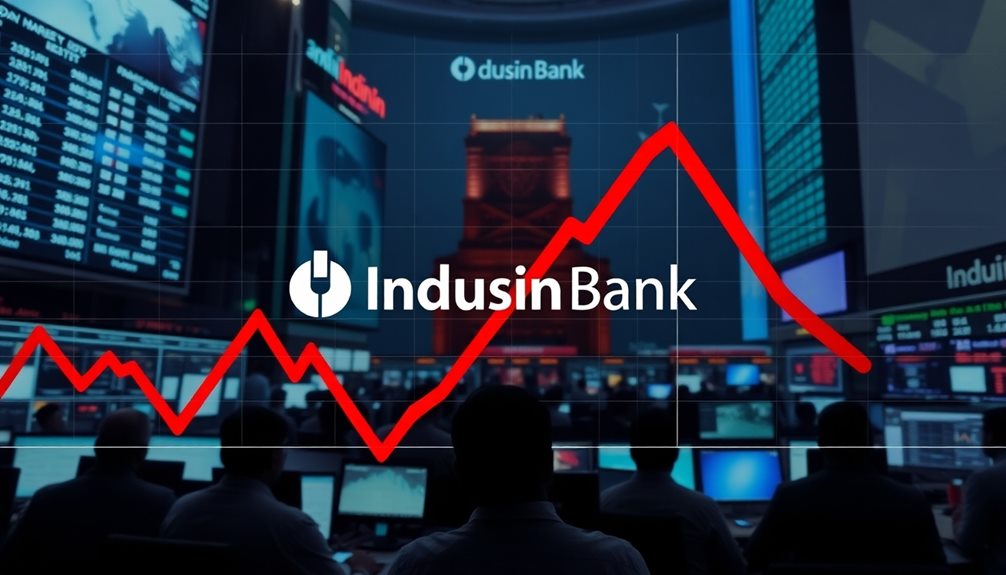The Nifty 50 index showcases India's top 50 largest and most liquid companies. It's a key indicator of the Indian stock market's health, revealing trends in investor sentiment. Recently, the index faced an 8.15% correction, signaling waning investor confidence, particularly with companies like IndusInd Bank dropping significantly. Market challenges have stemmed from softer earnings and political uncertainties, which affect economic stability. As you explore the giants within this index, understanding these dynamics can help you navigate potential risks and opportunities ahead. Keep going to uncover deeper insights into India's market landscape and what it means for your investments. Additionally, global economic factors and sector-specific challenges have further intensified market volatility, prompting investors to tread cautiously. Amid this backdrop, innovative investment strategies like Grayscale’s Solana ETF strategy are gaining traction, offering a diversified approach for those looking to hedge risks while tapping into emerging asset classes. By balancing traditional equity investments with such forward-looking strategies, investors can better position themselves to leverage both stability and growth opportunities in the evolving market landscape.
Key Takeaways
- The Nifty 50 index represents the 50 largest and most liquid companies on the NSE, covering about 65% of its market capitalization.
- Major companies like Reliance Industries, TCS, and HDFC Bank are key constituents of the Nifty 50 index.
- Recent market corrections highlight investor sentiment issues, with 23 Nifty 50 stocks trading significantly below their one-year highs.
- IndusInd Bank's performance decline reflects broader asset quality concerns affecting investor confidence in the banking sector.
- Political events and economic indicators play a crucial role in shaping market dynamics and investment strategies within the Nifty 50.
Introduction

Understanding the Nifty 50 Index is essential for anyone looking to navigate India's dynamic stock market. This benchmark index represents the weighted average of 50 of the largest and most liquid companies listed on the National Stock Exchange (NSE). By including major players like Reliance Industries, TCS, and HDFC Bank, the Nifty 50 provides a diversified view of the Indian economy, making it a vital tool for investors. The Nifty 50 serves as a reflection of the overall market sentiment and economic health, offering a key indicator for market trends. Investors often turn to the Nifty 50 stock market giants to assess broad industry performance and forecast future growth, as these companies contribute significantly to the country’s GDP. By investing in this index, one gains exposure to sectors such as technology, finance, and energy, encompassing the core of India’s robust economy.
As you track the performance of this index, you'll notice that it serves as a crucial indicator for investment strategies in the Indian equity market. The Nifty 50 has recently faced challenges, correcting by 8.15% from its record peak as of October 2023.
Despite this, historical data reveals its impressive potential, showing a compound annual growth rate (CAGR) of approximately 14.33% over various time frames. This growth highlights the Nifty 50's ability to deliver long-term investment returns, making it a focal point for anyone serious about investing in the stock market.
Background

The Nifty 50 index, a cornerstone of India's financial landscape, represents the performance of the top 50 large-cap companies on the National Stock Exchange. Covering about 65% of the free float market capitalization of the NSE, it serves as a crucial benchmark for investors and market participants.
The index is diverse, featuring companies across sectors like financial services, information technology, consumer goods, and energy. The index is diverse, featuring companies across sectors like financial services, information technology, consumer goods, and energy. This broad representation ensures a more comprehensive view of market trends and sector performance. Additionally, emerging industries and niche markets are increasingly making their presence felt, much like the growing global appeal of regions such as the Maldives Paradise Islands Overview, which highlights opportunities in tourism and sustainable development sectors. These dynamics reflect a constantly evolving economic landscape shaped by innovation and strategic growth.
As of October 2023, the Nifty 50 experienced a notable correction of 8.15% from its record peak. This decline stemmed from various factors, including softer-than-expected earnings and heightened market volatility.
You'll notice that 23 of its constituents were trading 15-37% below their one-year highs, signaling a decline in investor sentiment.
Political events, such as recent election results, can also impact market performance significantly. Investors often react to these results, influencing stock prices and overall market trends.
Understanding these dynamics can help you navigate the complexities of the Nifty 50 and make informed investment decisions. As market conditions evolve, staying updated on both economic indicators and political developments is essential for optimizing your investment strategy.
Indusind Bank Leads Decline

IndusInd Bank has taken a significant hit, plunging 37.4% from its recent high of ₹1,694, making it one of the biggest losers in the Nifty 50 index. This steep decline mirrors a larger trend, as 23 Nifty 50 constituents now trade between 15-37% below their one-year highs.
The bank's downturn is contributing to an overall negative market sentiment, with the Nifty 50 correcting by 8.15% from its peak. Recent earnings reports have revealed asset quality issues within banks, including IndusInd, further affecting investor outlook.
As you look at the broader economic landscape, it's clear that rising inflation expectations and indicators of an economic slowdown are making many investors cautious. The upcoming election adds another layer of uncertainty, as political dynamics can heavily influence market stability.
The selloff in IndusInd Bank reflects increased volatility and a retreat from riskier assets, making it essential for you to stay informed. As the market reacts to these conditions, it's crucial to evaluate your investment strategies, especially in light of how the election could impact future economic policies and overall investor sentiment.
Investor Confidence Wanes Sharply

As market volatility escalates, investor confidence has taken a sharp downturn, reflected in the Nifty 50's 8.15% correction from its record peak.
With 23 constituents trading 15-37% below their one-year highs, it's clear that many are feeling the pressure. The selloff continued into November, driven by a steep drop in market sentiment and increased volatility across major sectoral indices.
Foreign Portfolio Investors (FPIs) have withdrawn over ₹1 lakh crore in just 35 days, adding to the heightened selling pressure. Softer-than-expected Q2 earnings reports haven't helped either; brokerages are downgrading multiple sectors and revealing asset quality issues in banks.
Elevated inflation expectations and the looming threat of an economic slowdown are causing investors to rethink their strategies.
In this climate, many are questioning whether the economy would stabilize soon. This shift in focus towards macroeconomic stability has intensified caution among market participants.
As you navigate this uncertain landscape, it's crucial to stay informed and consider the wider implications for your investments. The current trends suggest that maintaining a conservative approach might be the wisest course of action for now.
Retirement Savings at Risk

With the Nifty 50's recent 8.15% correction, retirement savings tied to these investments are facing significant risks. If you've relied on the stock market for future income, this decline is troubling.
Many of the 23 constituents are trading 15-37% below their one-year highs, which can severely impact your portfolio's value. Economic growth projections aren't looking favorable either, with SBI estimating GDP growth could drop to 6.5% in Q2 FY25. This downturn may affect the companies within the Nifty 50 and their ability to deliver returns.
Moreover, softer-than-expected Q2 earnings have led to downgrades across sectors, heightening concerns for your retirement funds. The recent withdrawal of over ₹1 lakh crore by Foreign Portfolio Investors since late September adds more pressure on equity markets, further jeopardizing your investments.
Even former President Donald Trump's economic policies can't shield you from these market fluctuations. It's crucial to reassess your investment strategy and consider diversifying your portfolio to mitigate these risks.
As you plan for retirement, staying informed and proactive can help protect your savings amidst this volatile landscape.
Frequently Asked Questions
Who Is Indian Share Market Giant?
When you think of Indian share market giants, names like Reliance Industries, HDFC Bank, and Infosys come to mind. These companies dominate the market, significantly influencing trends and overall investor sentiment in India.
What Are the Top 3 Stocks of Nifty 50?
The top three stocks in the Nifty 50 are Reliance Industries, HDFC Bank, and Infosys. These companies lead in their respective sectors, driving significant market movements and shaping the economic landscape you interact with daily.
Which Companies Are Listed in Nifty 50 2024?
In 2024, you'll find major companies like HDFC Bank, Reliance Industries, Infosys, and Tata Consultancy Services listed in the Nifty 50. These firms play a crucial role in shaping the Indian stock market landscape.
Who Is the No. 1 Share Market King in India?
When you think about the No. 1 share market king in India, Rakesh Jhunjhunwala often comes to mind. His investment prowess and long-term strategies made him a legendary figure in the Indian stock market.










